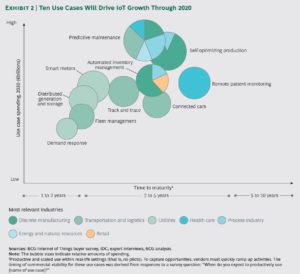Supporting Edge Computing and IoT with Modular Data Centers
Living on the Edge
The increase in sophisticated Internet of Things (IoT) devices is pushing cloud computing to the edge, literally. Currently all of the major cloud providers such a Amazon (AWS), Microsoft (Azure), and Google Cloud Platform operate in huge hyperscale data centers. These facilities are hundreds of thousands of square feet, and typically require over 50 MegaWatts of electrical power. Although most cloud providers operate multiple data centers across the world, there is sometimes thousands of miles between each of them, and to the users of the IoT devices.
As reported by Louis Columbus (Contributor, Forbes Magazine) the Boston Consulting Group (BCB) predicts that the areas of predictive maintenance, self-optimizing production, and automated inventory management will drive the growth of the IoT market (see image below). [1]

One of the main challenges with operation of the IoT under a hyperscale cloud infrastructure is the issue of latency, that is the physical cloud (data center) may not be anywhere close to the devices in use causing delays in data transfer. It is unrealistic to believe that every cloud company would construct enough hyper scale data centers to minimize the latency in transfer of data in every corner of the world, especially in areas that are more remote.
This has driven the industry to move to what’s known as “edge computing”, which brings the data processing element closer to the the IoT. It is moving away from the core of the cloud to the edge of the network, close to the action and the end user of the device.

Cloud to Edge Computing Relationship, Image Courtesy of Cisco
Who is Building the Edge?
The concepts of “X” as a Service (“X”aaS) and the software defined data center pushed enterprise companies to cloud platforms driving the need for the large hyperscale data centers previously noted. This fit the enterprise business model very well, but the centralized platform did not favor the decentralized model of smart phones, tablets, and other devices/sensors making up the IoT. There is a need for a decentralized, geographically dispersed infrastructure model consisting of a large number of smaller data centers all tying back into the centralized cloud facility.
Rick Crutchley, Chief Operating Officer of IO, a co-location & network data center company (www.io.com), participated in a industry round table discussion in Data Center Frontier online journal and noted that “The next step in modular data center solutions is what is referred to as Edge computing – smaller data centers placed closer to the end user for improved availability and latency.” [2]
A modular data center is a pre-fabricated building (typically constructed in a manufacturing facility) comprised of all of the elements of a larger facility. It contains all of the IT aspects of a brick and mortar solution – Compute, Network, & Storage, as well as the power and cooling infrastructure to support it. The modules are capable of rapid deployment and installation, and are scalable for growth and expansion. One such company, Baselayer (www.baselayer.com) is headquartered Chandler, Arizona. My employer, M+W Group, worked directly with Baselayer and one of the local electric utility companies, Salt River Project (www.srpnet.com), in a test case installation of a edge network.
The intent of the project was to showcase the modular approach to data centers, noting a cost, schedule, and energy efficiency while increasing the reliability due to the proximity to the utility substation. The prototype SRP DataStation was unveiled in the summer of 2015 at an installation in Gilbert, AZ. [3]

SRP DataStation installation in Gilbert, AZ. Photo Courtesy of SRP & Baselayer
The Baselayer “Edge” series is design to support the cloud and those applications which have sensitivity to latency. A single module for the cooling infrastructure (Chilled Water, Direct Expansion, or Evaporative Cooling) can support additional IT infrastructure modules. All manufacturing is performed in their facility located in Chandler, AZ. (www.baselayer.com)
One of the advantages of locating the DataStation adjacent to an electrical utility substation is the reliability of power supplied by the utility. Clint Poole, manager of SRP Telecom, noted that as such the module does not need the traditional standby power equipment of generators or UPS systems. [4] These components to the electrical infrastructure add capital cost and decrease the overall efficiency of the data center. [4] Baselayer has placed an online video on Youtube for a tour inside one of their modular facilities, best viewed with virtual reality goggles for the best experience, https://www.youtube.com/watch?v=QINOFn1EUOI.


Baselayer Manufacturing Facility, Chandler, AZ courtesy of Baselayer & East Valley Tribune
Will the Edge Overtake the Cloud?
Tom Bittman wrote in his post on Gartner Blog Network that there are some “overlapping trends in the data center industry, two of which are the centralizing of cloud computing for massive economies of scale and the growth of the IoT.” [5] He goes on to say that the centralized cloud is not agile enough to keep up with the dynamic pace of devices at the edge and latency from IoT to the hyperscale cloud facility is too great to keep up with the demand.
Currently there is a lack of infrastructure at the edge, however this does open the opportunity for companies who build modular, micro-data centers such as Baselayer to position themselves to capture a significant portion of the marketshare.
REFERENCES:
[2] https://datacenterfrontier.com/edge-iot-likely-to-boost-fortunes-of-modular-data-centers/.
[4] http://datacenterfrontier.com/datastation-brings-servers-to-the-heart-of-the-power-grid/
[5] http://blogs.gartner.com/thomas_bittman/2017/03/06/the-edge-will-eat-the-cloud/.


